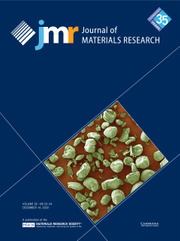Article contents
Unit Cell Indexing of Luminescent Tantalum Zinc Oxide
Published online by Cambridge University Press: 31 January 2011
Abstract
Tantalum zinc oxide (TZO) with the chemical formula Ta2Zn3O8 can be generated from the reaction of 3 mol ZnO and 1 mol Ta2O5 at elevated temperatures. This phase has been shown to exhibit blue cathodoluminescence at low electron beam voltages. It has also been realized in thin film form on silicon substrate, making TZO an important material for monolithic field emission display devices. The structure type of TZO has been investigated using powder x-ray diffraction techniques. The unit cell of this phase has been determined and found to be monoclinic. These results allow for indexing of the powder pattern first reported by Kasper in 1967 and correct for a discrepancy in the single-crystal structure lattice constants reported by Waburg and Muller-Buschbaum in 1984.
Information
- Type
- Articles
- Information
- Copyright
- Copyright © Materials Research Society 2000
References
REFERENCES
- 7
- Cited by

